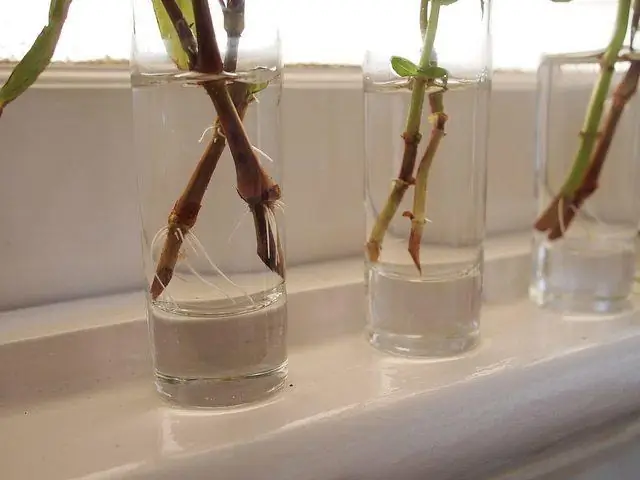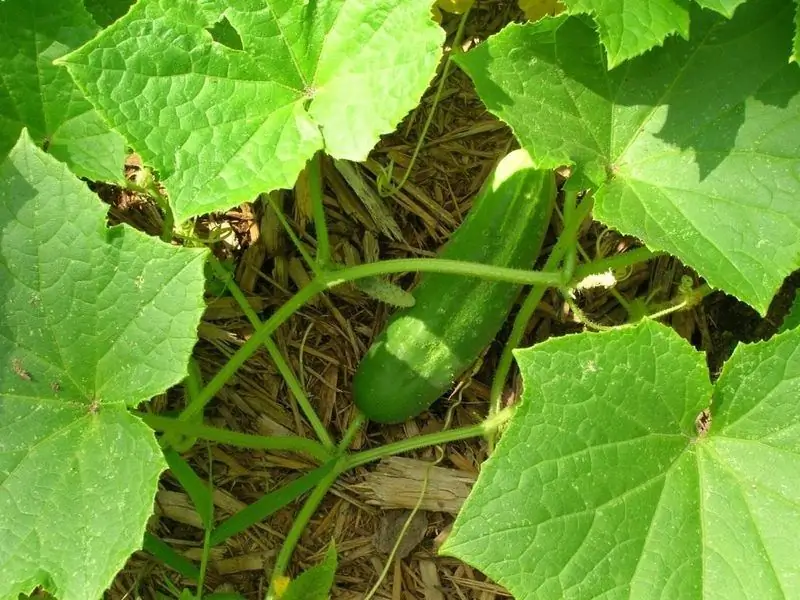
Table of contents:
- Author Bailey Albertson [email protected].
- Public 2023-12-17 12:53.
- Last modified 2025-01-23 12:41.
Useful tips for gardeners on growing greenery

Having fresh herbs on hand at all times is very important for those who love to cook on their own and care about their diet. And if you have your own land, then you can afford it. Most often, we grow the most common crops in our latitudes - dill, parsley. They are unpretentious and do not require much space and careful maintenance. But it is very important to know how to plant dill and parsley in the country so that they give a good harvest and do not wilted during growth.
Content
-
1 Parsley
1.1 How to plant
- 2 Tips for growing
-
3 Dill
- 3.1 How to plant
- 3.2 Tips for growing
- 4 Greens in your summer cottage
- 5 More valuable tips
- 6 Video on how to grow dill and parsley in the country
Parsley
Parsley has long and firmly occupied one of the first places among our favorite spices. You can grow two types of parsley on your plot:
- sheet (as well as curly) - to improve the taste and decorate dishes;
- root - for making sauces, pickling and pickling vegetables.
How to plant
Parsley is unpretentious, but requires a little attention. Sowing is carried out in April, or before winter, in November. In the second case, the parsley will begin to sprout a short time after the snow melts.

Prepare the soil correctly for planting parsley
The advantage of parsley is that it doesn't require much lighting. Before growing parsley in the country, you can choose a site for sowing both in an open sunny place and in the shade. On the sunny side, seedlings will appear earlier.
- Place the parsley seeds on a damp cloth (preferably cheesecloth) spread on a flat plate and leave for 3-5 days. After they begin to sprout, plant in the ground.
- Prepare the soil in the garden before planting. Thoroughly weed the weeds, picking out the roots, loosen the soil, break up the clods.
- Make grooves about 2 centimeters deep, keeping a distance of about 10 cm between them. It is better to take care of this in advance, during the autumn harvesting of the garden, when organic and mineral fertilizers are applied to the soil. In the spring, add additional urea, ammonium nitrate and potassium-phosphorus fertilizers.
- You may not pre-soak the seeds, but sow them dry into the prepared soil. But in this case, the parsley will rise much later. For example. If the landing time is the second half of April, then noticeable seedlings will appear by the end of May.
- Cover the area with the sown parsley with plastic wrap. This will help protect the seedlings from sudden cold weather.
Be sure to water your parsley bed, especially during dry periods. This will prevent the plant from turning yellow after the leaves are cut.
Growing tips
To keep parsley in your diet, sow it in stages, about once every 2 weeks. Thus, when you take one crop, the second will be "on the way." After the parsley sprouts, thin it out, leaving 7-15 cm between the bushes for the root variety and 20 cm for the leaf variety.
Besides sowing seeds, you can also grow green seedlings. Parsley is a biennial plant, so forcing can be done in winter and fresh parsley in spring. Take a few root parsley seedlings and plant them in a tall garden bed in early spring. Store the seedlings in the basement before planting with the roots in wet sand.

Proper planting and maintenance will provide you with a rich harvest of parsley
At the end of March, you can plant parsley seedlings. Its growth will be long, bushes will begin to form in a month. In this case, you need to choose an unshaded area for the garden. Already in early May, you will have a lot of fresh herbs.
Parsley tolerates cold temperatures down to -7 degrees below zero and does not die after snow falls, continuing to grow
At the end of autumn, root parsley is harvested in the same way as carrots: they are dug up, placed in boxes with dry sand and lowered into the basement. If the parsley bed is tall and dry, leave a few roots in the soil to get fresh greens in the spring after the snow melts.
Dill
It is impossible to imagine our cuisine without dill. Greens, flowers and seeds of this plant are used fresh in salads, first and second courses, preservation.
How to plant
Before planting, prepare the dill seeds so that later the plants turn out to be juicy and bushy.
- Fold the seeds, like parsley, in a damp gauze and leave for 3 days. At the same time, constantly monitor that the gauze does not dry out, and the moisture temperature is about +50 degrees. You need to change the water about 5 times a day.
- After treating the seeds with hot water, place them on cheesecloth or gauze bags, and cover with a damp cloth or steamed sawdust. Leave for 4 days at +20 degrees. During this time, the seeds will hatch.
- Dry the seeds for about half an hour immediately before sowing. Plant in well-moisturized soil.
- Planting can be done in April, after the snow melts. Parsley is not afraid of small cold snaps, it can grow at +3 degrees, but the best temperature regime is from 15 to 20 degrees.
- It is better to prepare dill beds in the fall. Dig up the ground 20 cm, fertilize with minerals and humus. In the spring, loosen and level the soil surface, make grooves 2 cm deep, with a distance of 20 cm between them, water and sow the seeds, sprinkle with earth and compact a little.
Growing tips
Unlike parsley, dill should be sown only in a sunny, unshaded area, otherwise the plant will turn out to be weak and dry.

Make sure that the dill does not go into the stem too early
To keep the dill from going into the stem and flowers too early, keep the soil moist at all times. Also, for this, you need to constantly thin out the plantings, leaving a distance of 8-10 cm between the bushes. This will ensure the growth of dill in density, and not upward.
Dill does not need feeding while it is growing. Since it is early ripening, the fertilizer obtained from the soil is sufficient for it. But if the bushes begin to turn yellow, this is a signal of a lack of nitrogen.
The crop is harvested 3-4 weeks after germination. At this time, the height of the greenery is 20-30 cm. Just pull the dill out of the soil right at the root.
Greens in your summer cottage






Some more valuable tips
You can grow dill and parsley on a windowsill. In this case, good, strong bushes will appear in a month. This will save seeds and get more greenery.
Dill can be planted even in winter. Remove the snow from the garden bed, spread out the seeds and cover with a layer of earth and humus. When the snow melts, the seeds under the influence of water will go underground and sprout there. In the spring, cover the bed with a film, securing it around the edges. Thus, you will receive greens 1-2 weeks earlier than with spring planting.

You can grow dill and parsley in the country all year round, for example, in winter - on a windowsill
Each variety of dill and parsley has its own characteristics. Some of them are more frost-resistant, some are not afraid of dryness or shading. Let's consider the most popular varieties in more detail.
- Dill variety "Lesnogorodskiy" has a strong aroma and retains juicy greens even during the formation of flowers and seeds. The bush is high, lush. Sowing is carried out at the end of May.
- The mushroom variety is early ripening, sown in spring. not picky about heat, resistant to diseases, gives a good harvest.
- The new Kibray variety is late ripening, has wide beautiful leaves. In spring it is planted in a greenhouse, since this variety is thermophilic and can get sick in cool summers.
- The Umbrella variety belongs to new, it is early ripening, gives abundant greenery of medium size. Grows well in greenhouses.
There are other varieties:
- Esto;
- Hanok;
- Superdukat;
- Dill;
- Kaskelensky.
They are not so popular, because they do not have special properties, but they are quite unpretentious in growing and caring for. You can get a good harvest from these varieties too.
Video on how to grow dill and parsley in the country
We hope these tips will help you grow parsley and dill properly to provide your diet with vitamin-rich greens. If you have any questions, please ask them in the comments. Have a nice harvest!
Recommended:
How To Grow A Peach From A Stone In The Country Or At Home + Video

Growing a peach from a stone at home. Step-by-step descriptions of growing and transplanting methods. Plant care
How To Grow Corn In The Country From Seeds Or Through Seedlings: When To Plant, How To Care And Other Features

Corn, features of its cultivation by seeds and seedlings, instructions for planting and care. List of popular varieties. Features for different regions. Video
How To Get Rid Of Mice In The Country, How To Scare Them Away, Folk Remedies To Combat Them

What are the best ways to deal with mice in the country. Description of the manufacture of traps, the use of poisons and ultrasonic repellents. Video
How To Plant And Grow Cucumbers In The Open Field: Plant Seeds, Properly Care For Plants (water, Form, Tie Up)

What varieties and hybrids of cucumbers can be grown in the open field. Features of planting seeds and seedlings. Choice of place and timing. The nuances of care and formation
Whiskers In Cats And Cats: What Are They Called Correctly And Why They Are Needed, What Will Happen If You Cut Them And Why They Fall Out Or Become Brittle

Features of the structure of the mustache in cats. What are they called and where they are located. What functions do they perform. What problems can a cat with a mustache have? Reviews
